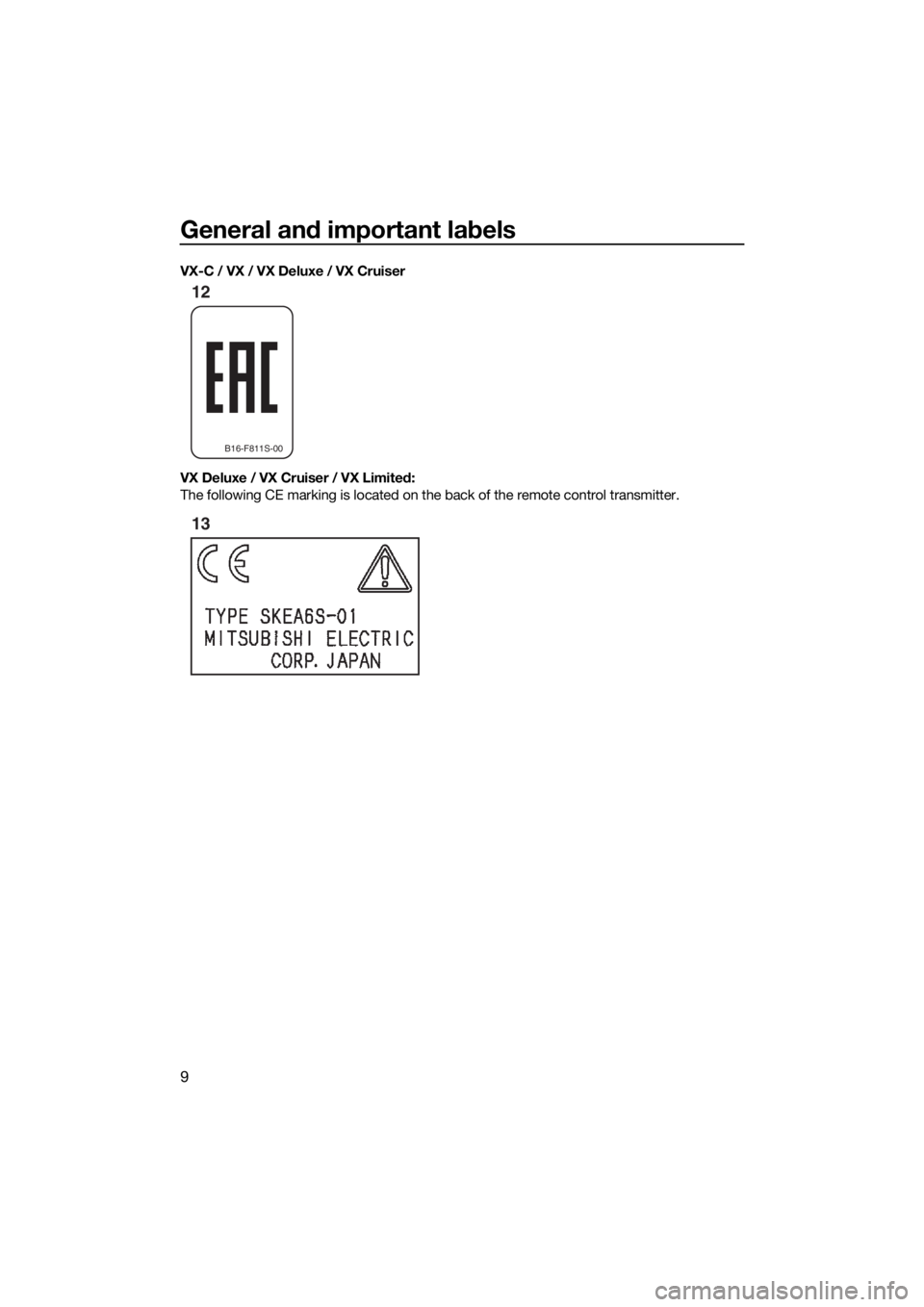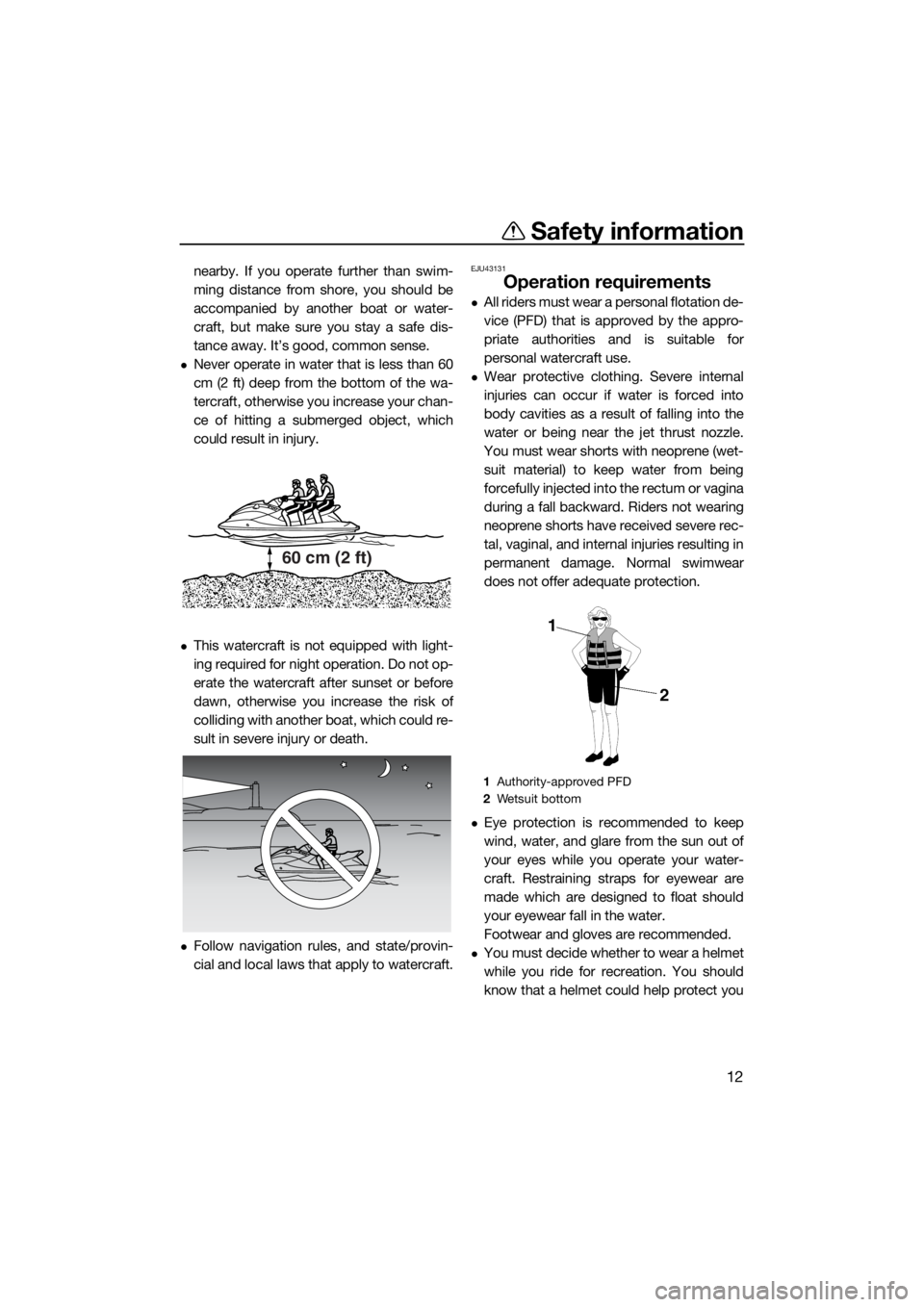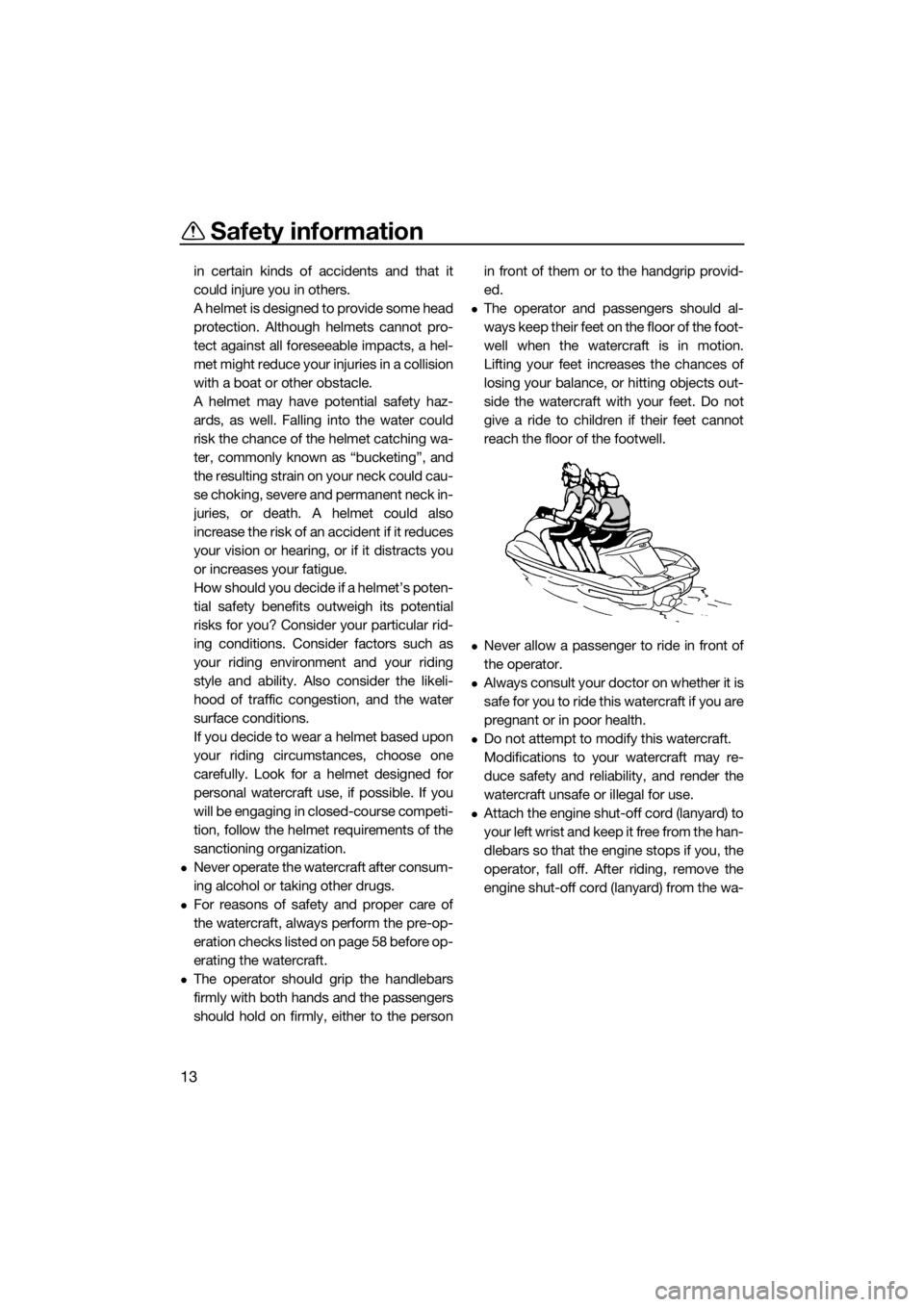YAMAHA VX-C 2020 User Guide
Manufacturer: YAMAHA, Model Year: 2020, Model line: VX-C, Model: YAMAHA VX-C 2020Pages: 110, PDF Size: 5.79 MB
Page 11 of 110

General and important labels
4
EJU30454
Important labels
Read the following labels before using this watercraft. If you have any questions, consult a
Yamaha dealer.
3
8
11
1
2
7
5
1249
13
6
10
UF4G74E0.book Page 4 Tuesday, July 16, 2019 10:27 AM
Page 12 of 110

General and important labels
5
EJU35914Warning labels
If any of these labels are damaged or missing, contact a Yamaha dealer for replacements.
1
UF4G74E0.book Page 5 Tuesday, July 16, 2019 10:27 AM
Page 13 of 110

General and important labels
6
3
4 2
F4E-U41E1-40
F3V-U41B1-30
F3V-U41B1-10
UF4G74E0.book Page 6 Tuesday, July 16, 2019 10:27 AM
Page 14 of 110

General and important labels
7
F0V-U41DB-12
F1S-U415B-11
5
6
7
F3V-U416A-10
F3V-U416A-30
UF4G74E0.book Page 7 Tuesday, July 16, 2019 10:27 AM
Page 15 of 110

General and important labels
8
EJU44232Other labels
F1B-U41F5-11
F1B-U41F5-21
6EY-43394-10
E5
B4F-F817K-00
E10
0499
8
910
11
UF4G74E0.book Page 8 Tuesday, July 16, 2019 10:27 AM
Page 16 of 110

General and important labels
9
VX-C / VX / VX Deluxe / VX Cruiser
VX Deluxe / VX Cruiser / VX Limited:
The following CE marking is located on the back of the remote control transmitter.
B16-F811S-00
12
13
UF4G74E0.book Page 9 Tuesday, July 16, 2019 10:27 AM
Page 17 of 110

Safety information
10
EJU30683
The safe use and operation of this water-
craft is dependent upon the use of proper
riding techniques, as well as upon the
common sense, good judgment, and ex-
pertise of the operator. Before using this
watercraft, make sure that its use is per-
mitted under local laws, bylaws, and regu-
lations, and always operate the watercraft
in full conformity with any requirements
and limitations imposed. Every operator
should know the following requirements
before riding the watercraft.
Before operating the watercraft, read this
owner’s/operator’s manual, the Riding
Practice Guide, the Riding Instruction card,
and all labels on the watercraft. These ma-
terials should give you an understanding of
the watercraft and its operation.
Never allow anyone to operate this water-
craft until they too have read this own-
er’s/operator’s manual, the Riding Practice
Guide, the Riding Instruction card, and all
labels.
EJU30743
Limitations on who may
operate the watercraft
Make sure that the operator is 16 years of
age or older and has taken a boater safety
course.
Adults must supervise use by minors.
This watercraft is designed to carry the op-
erator and up to 2 passengers. Never ex-
ceed the maximum load limit or allow more
than 3 persons (or 2 persons if a wake-
boarder or water-skier is being pulled) to
ride the watercraft at any time.
Do not operate the watercraft with any pas-
sengers on board until you have consider-
able practice and experience riding alone.
Operating the watercraft with passengers
requires more skill. Take the time to be-
come accustomed to the handling charac-
teristics of the watercraft before trying any
difficult maneuvers.Maximum load:
240 kg (530 lb)
Load is the total weight of cargo, op-
erator, and passengers.
UF4G74E0.book Page 10 Tuesday, July 16, 2019 10:27 AM
Page 18 of 110

Safety information
11
EJU44481
Cruising limitations
Scan constantly for people, objects, and
other watercraft. Be alert for conditions
that limit your visibility or block your vision
of others.
Operate defensively at safe speeds and
keep a safe distance away from people,
objects, and other watercraft.
Do not follow directly behind watercraft or
other boats.
Do not go near others to spray or splash
them with water, go too close to other
boats, or go too fast for the traffic condi-
tions.
VX-C: Take early action to avoid collisions.
Remember, watercraft and other boats do
not have brakes.
VX-C: Avoid sharp turns or other maneu-
vers that make it hard for others to avoid
you or understand where you are going.
VX / VX Deluxe / VX Cruiser / VX Limited:
Take early action to avoid collisions. Re-
member, watercraft and other boats do not
have brakes. In addition, the Reverse with
Intuitive Deceleration Electronics (RiDE)
system is not a braking device for avoiding
dangerous situations. The RiDE system is
an electronic system for controlling the en-
gine speed and reverse gate, which is lo-
cated near the jet thrust nozzle. The RiDE
lever located at the left handlebar grip canbe used to change the direction of the jet
thrust so that the watercraft moves in re-
verse or is in neutral. The RiDE system as-
sists the operator when slowing down and
during slow-speed maneuvering, such as
launching, beaching, and docking.
VX / VX Deluxe / VX Cruiser / VX Limited:
Avoid sharp turns, slowing down rapidly by
squeezing the RiDE lever forcefully, and
other maneuvers that make it hard for oth-
ers to avoid you or understand where you
are going.
Avoid areas with submerged objects or
shallow water.
Do not release the throttle lever when trying
to steer away from objects—as with other
powerboats, you need throttle to steer. Al-
ways check throttle and steering controls
before starting the watercraft.
Ride within your limits and avoid aggres-
sive maneuvers to reduce the risk of loss of
control, ejection, and collision.
This is a high performance boat—not a toy.
Avoid aggressive operation, sharp turns,
and unexpected acceleration that can cau-
se you to be thrown off. Do not jump waves
or wakes—jumping can cause injuries such
as back or spinal injuries (paralysis), facial
injuries, and broken legs, ankles, and other
bones. Improper operation can result in se-
vere injury or death.
Do not operate the watercraft in rough wa-
ter, bad weather, or when visibility is poor;
this may lead to an accident causing injury
or death. Be alert to the possibility of ad-
verse weather. Take note of weather fore-
casts and the prevailing weather
conditions before setting out on your wa-
tercraft.
As with any water sport, you should not op-
erate your watercraft without someone else
UF4G74E0.book Page 11 Tuesday, July 16, 2019 10:27 AM
Page 19 of 110

Safety information
12
nearby. If you operate further than swim-
ming distance from shore, you should be
accompanied by another boat or water-
craft, but make sure you stay a safe dis-
tance away. It’s good, common sense.
Never operate in water that is less than 60
cm (2 ft) deep from the bottom of the wa-
tercraft, otherwise you increase your chan-
ce of hitting a submerged object, which
could result in injury.
This watercraft is not equipped with light-
ing required for night operation. Do not op-
erate the watercraft after sunset or before
dawn, otherwise you increase the risk of
colliding with another boat, which could re-
sult in severe injury or death.
Follow navigation rules, and state/provin-
cial and local laws that apply to watercraft.
EJU43131
Operation requirements
All riders must wear a personal flotation de-
vice (PFD) that is approved by the appro-
priate authorities and is suitable for
personal watercraft use.
Wear protective clothing. Severe internal
injuries can occur if water is forced into
body cavities as a result of falling into the
water or being near the jet thrust nozzle.
You must wear shorts with neoprene (wet-
suit material) to keep water from being
forcefully injected into the rectum or vagina
during a fall backward. Riders not wearing
neoprene shorts have received severe rec-
tal, vaginal, and internal injuries resulting in
permanent damage. Normal swimwear
does not offer adequate protection.
Eye protection is recommended to keep
wind, water, and glare from the sun out of
your eyes while you operate your water-
craft. Restraining straps for eyewear are
made which are designed to float should
your eyewear fall in the water.
Footwear and gloves are recommended.
You must decide whether to wear a helmet
while you ride for recreation. You should
know that a helmet could help protect you
60 cm (2 ft)
1Authority-approved PFD
2Wetsuit bottom
UF4G74E0.book Page 12 Tuesday, July 16, 2019 10:27 AM
Page 20 of 110

Safety information
13
in certain kinds of accidents and that it
could injure you in others.
A helmet is designed to provide some head
protection. Although helmets cannot pro-
tect against all foreseeable impacts, a hel-
met might reduce your injuries in a collision
with a boat or other obstacle.
A helmet may have potential safety haz-
ards, as well. Falling into the water could
risk the chance of the helmet catching wa-
ter, commonly known as “bucketing”, and
the resulting strain on your neck could cau-
se choking, severe and permanent neck in-
juries, or death. A helmet could also
increase the risk of an accident if it reduces
your vision or hearing, or if it distracts you
or increases your fatigue.
How should you decide if a helmet’s poten-
tial safety benefits outweigh its potential
risks for you? Consider your particular rid-
ing conditions. Consider factors such as
your riding environment and your riding
style and ability. Also consider the likeli-
hood of traffic congestion, and the water
surface conditions.
If you decide to wear a helmet based upon
your riding circumstances, choose one
carefully. Look for a helmet designed for
personal watercraft use, if possible. If you
will be engaging in closed-course competi-
tion, follow the helmet requirements of the
sanctioning organization.
Never operate the watercraft after consum-
ing alcohol or taking other drugs.
For reasons of safety and proper care of
the watercraft, always perform the pre-op-
eration checks listed on page 58 before op-
erating the watercraft.
The operator should grip the handlebars
firmly with both hands and the passengers
should hold on firmly, either to the personin front of them or to the handgrip provid-
ed.
The operator and passengers should al-
ways keep their feet on the floor of the foot-
well when the watercraft is in motion.
Lifting your feet increases the chances of
losing your balance, or hitting objects out-
side the watercraft with your feet. Do not
give a ride to children if their feet cannot
reach the floor of the footwell.
Never allow a passenger to ride in front of
the operator.
Always consult your doctor on whether it is
safe for you to ride this watercraft if you are
pregnant or in poor health.
Do not attempt to modify this watercraft.
Modifications to your watercraft may re-
duce safety and reliability, and render the
watercraft unsafe or illegal for use.
Attach the engine shut-off cord (lanyard) to
y o u r l ef t w r is t an d k ee p i t fr e e f r o m t h e h an -
dlebars so that the engine stops if you, the
operator, fall off. After riding, remove the
engine shut-off cord (lanyard) from the wa-
UF4G74E0.book Page 13 Tuesday, July 16, 2019 10:27 AM